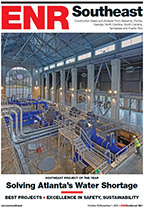Contractors broke ground June 2 in Gallup, N.M., for the first phase of the $1-billion Navajo-Gallup Water Supply Project. The aqueduct network will ultimately deliver 37,376 acre-feet of water annually from the San Juan River to approximately 250,000 people by the year 2040, including 43 Navajo chapters, the city of Gallup and the Teepee Junction region of the Jicarilla Apache Nation.
The project, which includes 280 miles of pipeline, 24 pump stations, two water treatment plants and numerous storage facilities, is one of 14 high-priority infrastructure projects set aside by the Obama Administration for an expedited permitting and environmental-review process.
Design and construction of the project will be jointly led by the Bureau of Reclamation, the Navajo Nation, the City of Gallup and the Indian Health Service.
“The project is the cornerstone piece of the New Mexico water rights settlement between the Navajo Nation, the state of New Mexico and the United States, and provides a long-term sustainable water supply for areas reliant on groundwater supplies that are dwindling and of poor quality,” says Barry Wirth, regional public affairs officer at the Bureau of Reclamation.
Erny Zah, director of communications for the office of the president and vice president of the Navajo Nation, says the project is welcome relief to many of his people in the Navajo Nation where as many as “40% to 60% of families are hauling water,” he says.
According to Wirth, the contractor will construct the project in a sequence that will convey water to areas with the most immediate and critical water needs in two to three years.
In April, the Bureau of Reclamation awarded a $10.75-million contract to Boise-based McMillen LLC for phase 12A construction, which involves laying approximately four miles of 36- to 48-inch pipeline about eight miles north of Gallup.
Constructing the pipeline will entail a number of technical and logistical challenges, says Marissa Emmons, director of marketing for McMillen LLC. “Segments of the pipeline will be constructed down steep slopes requiring rock excavation and special restoration activities. There are also numerous utility and roadway crossings,” Emmons says.
The Dept. of the Interior estimates that 400-450 jobs will be created from multiple contracts awarded in the first year, increasing to 600-650 estimated jobs at the peak of construction.




Post a comment to this article
Report Abusive Comment